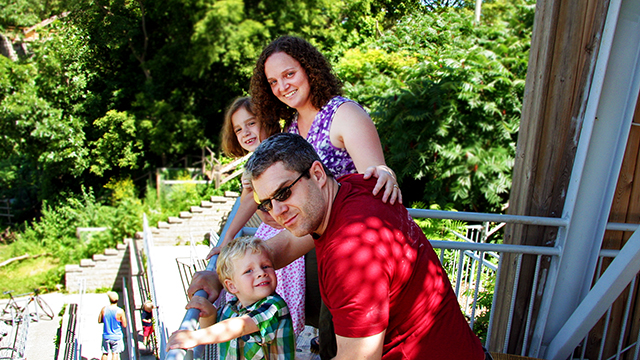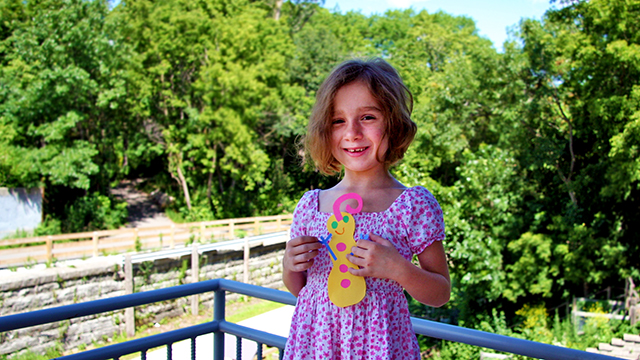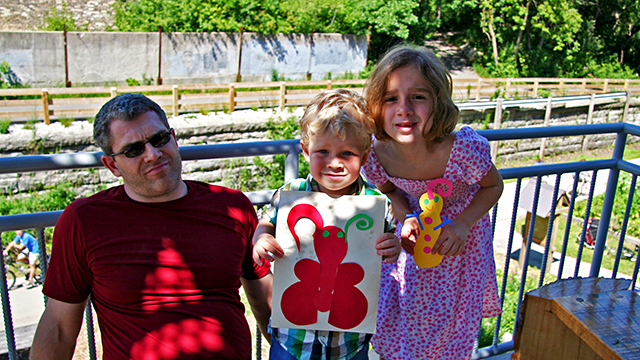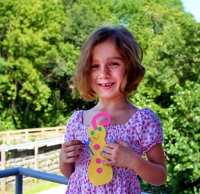“They’re in the Animal Room,” she said. “Alden always needs to stop there first. Well, there and the slide.”
Andreas walked out of the animal room with Alden in his arms.
“I want to go on the slide!” Alden declared, as Kirsten predicted.
A volunteer receptionist apologetically explained that due to construction in Riverside Park, the outdoor access to the top of the slide was temporarily closed.
Alden’s sweet, excited grin began to turn downward when he learned the fate of his beloved slide. Mom gave him a knowing smile that silently said “Go ahead,” and within a blink of an eye, he ran up the slide, scrambling joyfully to the top.
Alden’s unconventional work–around serves as a metaphor for the Beyer’s collective engagement with the world around them. In their own ways, each family member applies creativity and ingenuity to solve problems that are important to them. There is no doubt that this family is ambitious and pioneering, as evidenced by their willingness to embrace challenges and reframe them into opportunities.

Andreas, who is originally from Germany, met Kirsten while they were both pursuing doctoral degrees (genetics and geography, respectively) at the University of Iowa. Post-doctoral opportunities and faculty positions at the Medical College of Wisconsin brought them to Milwaukee. Nature has always been an integral part of the Beyer’s lives, and Kirsten immediately began researching ways they could access nature in their new city. A few months after arriving in Milwaukee, she discovered the Urban Ecology Center.
Life got in the way, as it often can, and becoming Urban Ecology Center members became one of many things on the family’s to do list. It wasn’t until the Center reached out to Kirsten as a researcher that the family became members. Since then, they have been involved in many ways, from B’earthday parties to festivals. Sophie has attended two very unique Urban Ecology Center camps that aligned with her creative spirit—one that featured a partnership between the Wisconsin Conservatory of Music and the “Arts Outside!” camp at our Washington Park Branch. Kirsten shared that after Sophie attended the camps, she seemed “happier, inspired, and more grounded.”

Sophie (who attends Milwaukee German Immersion School) made nature-inspired art as I talked with her parents. She proudly displayed her Schneeman, which she explained is the German translation of Snowman.
It’s clear that Andreas and Kirsten think holistically about their children’s well-being, as well as the shared health of their community. Their work at the Medical College reflects these value-informed perspectives. Andreas runs a research lab that, among many objectives, examines the role of telomerase, an enzyme that is related to the aging, growth, and resilience of cells in the context of cardiovascular health. Click here to learn more about Andreas' work.
It’s difficult to succinctly define all of Kirsten’s academic, professional, and community-based roles. She describes herself as a health geographer, and explained her work in mapping diseases as well as her study of the social determinants of health underlying human-environmental transactions such as violence and racial segregation. Her eyes began to shine when she began discussing her recent passions: researching health impacts of activated green space in urban neighborhoods.
Kirsten is a natural community collaborator. With the partnership of Urban Ecology Center stakeholders, MCW colleagues, and her intuition, she developed a research project integrating and assessing the impact of the Center’s Menomonee Valley Branch and Menomonee Valley Partners’ efforts to activate green space and provide environmental education and resources on the south side of Milwaukee. The proposal was accepted and funded by the Healthier WI Partnership Program (www.mcw.edu/healthierwipartnerships), which initiated a complex, reciprocally beneficial partnership between Urban Ecology Center education and evaluation staff and MCW Community Medicine professionals. As a representative of the Institute for Health and Society, Kirsten served as the study’s primary investigator, leading the academic charge that brought the project— More Than a Pretty Place: Activating Urban Parks to Improve Community Health and Wellness—to life. She works closely with the Center’s Senior Director of Education and Strategic Planning, Beth Heller, in carrying out this project, and is proud to consider Beth as a respected colleague and friend.
For more information on this pioneering study that has sparked exponential inspiration and energy within the community, see:
Healthier WI Partnerships: More Than a Pretty Place
Wisconsin Planners Conference Presentation 2013- More Than a Pretty Place
As an emerging community psychologist, I am in awe of the work Kirsten and her team have accomplished. Even more impressive and admirable is the Beyer’s ability to integrate their values into their professional identities, parenting, and community engagement. Kirsten describes Milwaukee as a progressive and down-to-earth community with strong energy around commitment to positive social change. She talks enthusiastically about all of the ways she sees the Urban Ecology Center as a “model prototype” for other cities to address countless social issues including homicide patterns, aggression, domestic violence, environmental justice, fair housing, and gentrification.
Kirsten explained her perspective on environment as the common thread that runs through many disciplines: public health, epidemiology, psychology, education, urban planning, social justice, etc.
“I am most interested in what happens in the spaces in between these disciplines,” she explains. “That’s where good things happen and new ideas emerge.”
Her talents in converging disciplines, navigating new spaces between the spheres of these content areas, and extracting the “good” are remarkable. I find it curious that Andreas examines complex systems on a very small, microscopic level, while Kirsten analyzes trends and data that emerge across a broad landscape. The kids seem to weave in and out of this dichotomy as well, which makes me wonder if they mirror some of their parents’ characteristics. Alden explores the world in quick, tactile movements, darting from place to place and leaving a trail of energy that others (in this case, his Dad) follow. I saw Sophie look at objects closely, make eye contact as she spoke to me, convey genuine interest, and take her time with her words.
In all the ways the Beyer’s interact with their environment, community, and one another, they serve as an inspiring example of how energy, intuition, and ambition can connect and grow what’s “good in the places in between.”

Alden also "dropped-in" to the Center's Science Saturdays Program and made a Schmetterling. Sophie added "That means butterfly in German".





